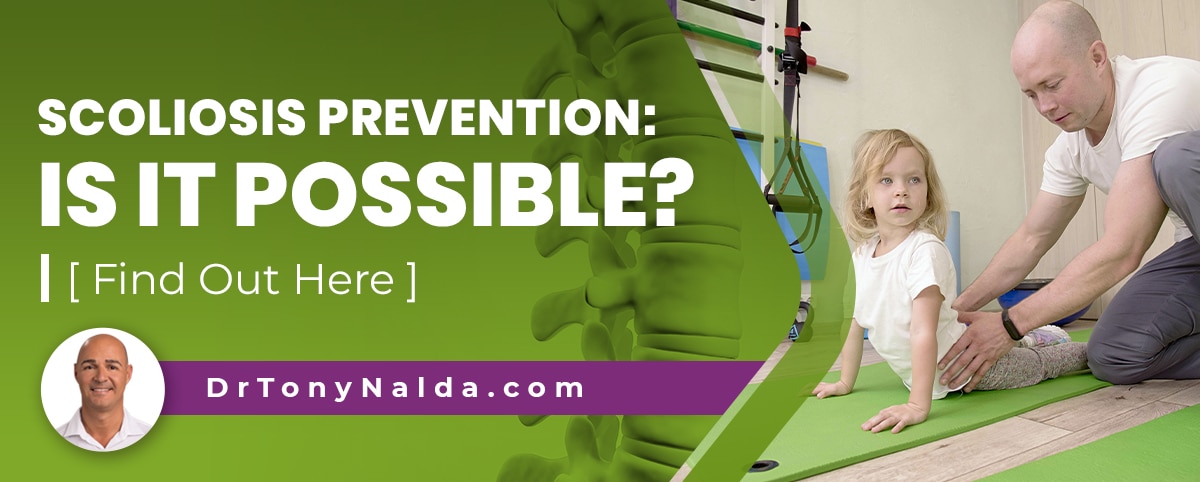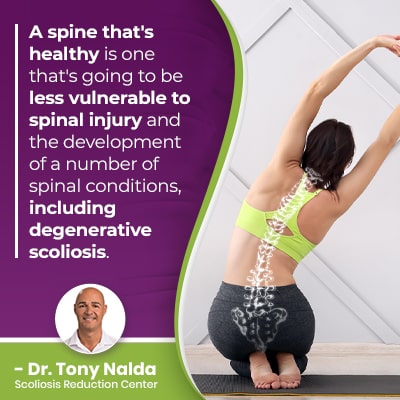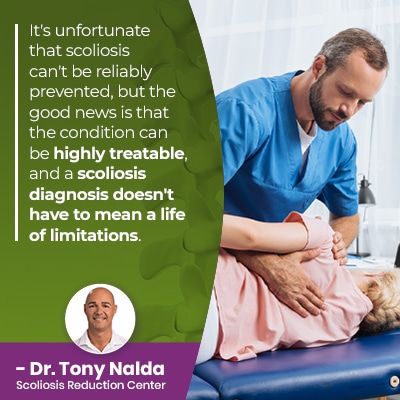Scoliosis Prevention: Is It Possible? [ Find Out Here ]

Although we don't fully understand what causes most cases of scoliosis to develop, we do know how to treat it effectively. While the development of scoliosis can't be prevented, there are certain lifestyle factors that can affect a person's spinal health and rate/level of age-related spinal degeneration: two factors that can affect the spine's ability to maintain its natural curves and alignment.
No one can prevent scoliosis from developing, but in many cases, what we can prevent is the condition from getting worse. As a progressive condition, the nature of scoliosis is to get worse over time, but it can be highly treatable, particularly when early detection and intervention are achieved.
Most cases of scoliosis aren't preventable because they are idiopathic, meaning the cause is unknown, but let's first address the different types of scoliosis because their causation is different.
Table of Contents
Different Types of Scoliosis
Scoliosis is the development of an unnatural sideways-bending and rotating spinal curve, and it ranges widely in severity from mild scoliosis to moderate scoliosis and severe to very severe scoliosis.
While there are different types of scoliosis, all types are progressive so are virtually guaranteed to get worse over time; curve progression means the size of the unnatural spinal curve is increasing, as are the condition's uneven forces, and their effects.
So scoliosis gets more complex to treat the more it progresses, not only because the abnormal curvature of the spine is getting larger, but because with progression, spinal rigidity increases, making the spine less responsive to treatment.
Now, the most common type of scoliosis to affect all ages is idiopathic scoliosis, meaning not clearly associated with a single-known cause, and this type accounts for 80-percent of known diagnosed cases; the remaining 20 percent are associated with known causes and have different treatment needs.
Neuromuscular scoliosis is caused by the presence of a larger neuromuscular condition such as spina bifida, muscular dystrophy, or cerebral palsy.
Because neuromuscular scoliosis develops as a secondary complication of a larger medical condition, neuromuscular scoliosis tends to be severe, so it can be far more difficult to prevent progression with this type than it is in idiopathic scoliosis cases that are considered typical.
Congenital scoliosis is caused by a malformed spine that develops in utero, and in these cases, due to the unique challenges of treating patients of such a young age and congenital scoliosis being atypical, preventing progression can, again, be more challenging.
The last condition type with a known cause is degenerative scoliosis, and I'd like to focus on this form because if there is a specific type of scoliosis with the most potential of being affected by preventative measures, it's degenerative scoliosis.
Degenerative Scoliosis and Prevention
 Degenerative scoliosis is caused by natural age-related spinal degeneration, but as a person's rate and level of spinal degeneration is affected by lifestyle factors, leading a spine-friendly lifestyle can help preserve the health and function of the spine, while preventing spinal degeneration.
Degenerative scoliosis is caused by natural age-related spinal degeneration, but as a person's rate and level of spinal degeneration is affected by lifestyle factors, leading a spine-friendly lifestyle can help preserve the health and function of the spine, while preventing spinal degeneration.
A spine that's healthy is one that's going to be less vulnerable to spinal injury and the development of a number of spinal conditions, including degenerative scoliosis.
Spinal degeneration generally starts with the intervertebral discs that sit between adjacent vertebrae providing the spine with structure, flexibility, cushioning between vertebral bodies, and facilitating its ability to evenly absorb/distribute stress.
If one or more of the discs start to deteriorate, the health and function of the spine can be greatly disrupted; disc degeneration affects the position of adjacent vertebrae that are attached to the disc in between.
As the shape of a disc changes, it can disrupt the structure and alignment of the spine as the vertebrae attached become unnaturally tilted.
Lifestyle factors that can affect spinal degeneration include weight, activity level, consumption of alcohol and/or smoking, posture, and how heavy objects are lifted.
Leading a Spine-Friendly Lifestyle
So while scoliosis isn't considered to be a preventable condition overall, leading a spine-friendly lifestyle can certainly help preserve spinal health, strength, and function, and this can reduce the spine's amount of degeneration, making it less likely to develop degenerative spinal conditions, including degenerative scoliosis.
Carrying excess weight isn't good for spinal health as this means more weight on the joints of the spine and more pressure on its individual structures, including the intervertebral discs.
Leading a sedentary lifestyle is contrary to the spine's movement-based design, and as it's through movement and increasing circulation that nutrients needed for repair are made accessible to the discs through a process similar to osmosis, staying active has the benefit of keeping the spinal discs hydrated and healthy.
Excessive consumption of alcohol and/or smoking affects overall health, and can also specifically impact spinal health because they can contribute to disc desiccation.
Chronic poor posture can also impact spinal health by introducing adverse spinal tension that, over time, can affect the position of certain vertebrae and the muscles that run alongside the spine to support it.
Particularly for people whose occupations involve repeatedly lifting heavy objects, not lifting properly with the legs, rather than straining the back, can contribute to injury, strain, and premature spinal degeneration.
Basically, anything that impacts the health of the spinal discs has the potential to cause spinal degeneration; the development of degenerative disc disease is a contributing factor in the development of a number of spinal conditions/issues.
So while leading a spine-friendly lifestyle can't prevent the development of scoliosis in general, leading a spine-friendly lifestyle can help prevent/limit spinal degeneration, which can help prevent the development of scoliosis known to be caused by degenerative changes the spine is experiencing.
How Can Scoliosis Treatment Help Prevent Progression?
It's unfortunate that scoliosis can't be reliably prevented, but the good news is that the condition can be highly treatable, and a scoliosis diagnosis doesn't have to mean a life of limitations.
 When a patient receives a diagnosis of scoliosis, the most important decision to be made is how to treat it moving forward; different treatment options offer different potential outcomes.
When a patient receives a diagnosis of scoliosis, the most important decision to be made is how to treat it moving forward; different treatment options offer different potential outcomes.
While traditional scoliosis treatment doesn't have a strategy for addressing scoliosis while mild and doesn't respond to a diagnosis proactively, modern conservative treatment is started as close to the time of diagnosis as possible; this is when treatment success is most likely.
There are no treatment guarantees, but with early detection and early intervention, there are fewer limits to what can be achieved because the milder scoliosis is, the more flexible the spine is, and the more likely it is to respond to treatment favorably.
Here at the Scoliosis Reduction Center, my patients benefit from a conservative treatment approach that's integrative and combines multiple condition-specific treatment disciplines capable of impacting conditions on every level: chiropractic care, physical therapy and scoliosis-specific exercises, corrective bracing, and rehabilitation.
Chiropractic care works towards realigning the spine by reducing the size of the unnatural spinal curve on a structural level, and physical therapy and scoliosis-specific exercises can help improve posture and strengthen core strength so the spine can be optimally supported and stabilized by its surrounding muscles.
Corrective bracing can complement other forms of treatment by pushing the spine into a corrective position, and rehabilitating a scoliotic spine can involve continued chiropractic care and a series of custom-prescribed home exercises so spines can be further stabilized and healed from home.
I customize each and every treatment plan to ensure key patient/condition variables are addressed.
Conclusion
While practicing a spine-friendly lifestyle can help preserve spinal health and prevent the development of degenerative scoliosis, most types of scoliosis are idiopathic and aren't caused by spinal degeneration.
Scoliosis introduces a lot of uneven forces to the body that can disrupt its overall symmetry: uneven shoulders, uneven hips, the development of a rib cage arch, uneven hips, and changes to gait, balance, coordination are common symptoms.
In children, the main symptom is postural deviation, and in adults, it's pain; scoliosis doesn't become a compressive condition until skeletal maturity has been reached, when compression of the spine and its surrounding muscles and nerves is no longer counteracted by growth.
Growth spurts are what triggers scoliosis to progress, and in the condition's most-prevalent type, adolescent idiopathic scoliosis, diagnosed between the ages of 10 and 18, this age group is the most at risk for rapid-phase progression due to rapid and unpredictable growth spurts.
When scoliosis is diagnosed, patients have an important decision to make; how scoliosis is treated can affect long-term spinal health and function, so don't hesitate to reach out for guidance and support.
Dr. Tony Nalda
DOCTOR OF CHIROPRACTIC
After receiving an undergraduate degree in psychology and his Doctorate of Chiropractic from Life University, Dr. Nalda settled in Celebration, Florida and proceeded to build one of Central Florida’s most successful chiropractic clinics.
His experience with patients suffering from scoliosis, and the confusion and frustration they faced, led him to seek a specialty in scoliosis care. In 2006 he completed his Intensive Care Certification from CLEAR Institute, a leading scoliosis educational and certification center.
About Dr. Tony Nalda
 Ready to explore scoliosis treatment? Contact Us Now
Ready to explore scoliosis treatment? Contact Us Now





